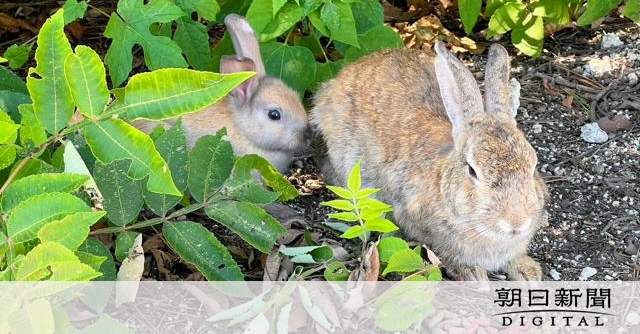瀬戸内「ウサギ島」77匹のウサギが死亡、死因は依然不明

瀬戸内「ウサギ島」77匹のウサギが死亡、死因は依然不明. Discover more detailed and exciting information on our website. Click the link below to start your adventure: Visit Best Website. Don't miss out!
Table of Contents
77 Rabbits Dead on Okunoshima ("Rabbit Island"): Cause of Death Remains a Mystery
The idyllic island of Okunoshima, famed worldwide as "Rabbit Island" for its thriving population of wild rabbits, is grappling with a devastating tragedy. A recent count has revealed the shocking death of 77 rabbits, leaving residents and animal welfare advocates searching for answers. The cause of death remains a mystery, sparking concerns and investigations across the Seto Inland Sea region.
This sudden and significant loss represents a substantial portion of the island's rabbit population, raising serious questions about the health and future of this unique ecosystem. The incident has garnered significant international attention, highlighting the vulnerability of even seemingly thriving wildlife populations.
The Discovery and Initial Investigations
The alarming discovery was made [Insert Date] by local officials and volunteers who regularly monitor the island's rabbit population. Initial reports indicated that the deceased rabbits were found scattered across various locations on Okunoshima, prompting immediate concerns about a potential infectious disease outbreak or environmental poisoning.
- No Obvious Signs of Trauma: Authorities have reported that there were no visible signs of trauma on the deceased animals, ruling out immediate causes such as predation or intentional harm.
- Ongoing Necropsies: Samples have been sent to veterinary laboratories for detailed analysis, including necropsies to determine the cause of death. Results are expected within [Insert timeframe, e.g., "the next few weeks"].
- Environmental Testing Underway: Simultaneously, environmental tests are underway to rule out any potential toxins or pollutants in the island's water supply or vegetation.
Impact on Okunoshima's Tourism and Ecosystem
Okunoshima, located in the Seto Inland Sea of Japan, has become a popular tourist destination precisely because of its abundant rabbit population. The sudden death of so many rabbits is expected to have a significant impact on the local economy and the island's unique ecosystem.
- Concerns for Tourism: The incident casts a shadow over the island's tourism industry, raising concerns amongst visitors and potentially impacting future bookings. Local businesses are understandably worried about the economic repercussions.
- Ecosystem Disruption: The loss of 77 rabbits, a considerable portion of the population, could potentially disrupt the delicate balance of the island's ecosystem. Further monitoring is crucial to assess the long-term effects.
Calls for Transparency and Further Investigation
Local residents and animal welfare organizations are calling for complete transparency and a thorough investigation into the deaths. Many are expressing frustration at the lack of immediate answers and demanding swift action to prevent further losses.
What needs to happen next?
- Rapid Dissemination of Findings: Authorities must swiftly share the results of the necropsies and environmental testing to alleviate public concern and guide future preventative measures.
- Enhanced Monitoring: Increased monitoring of the remaining rabbit population is crucial to detect any potential signs of illness or further mortality.
- Long-Term Conservation Plan: The tragedy highlights the need for a comprehensive, long-term conservation plan to protect Okunoshima's rabbit population and ensure the island's unique ecosystem remains healthy and vibrant.
The mystery surrounding the deaths of 77 rabbits on Okunoshima demands immediate attention. The island’s future, both ecologically and economically, depends on a swift and effective response. We will continue to update this story as more information becomes available. Stay tuned for further developments.
Keywords: Okunoshima, Rabbit Island, Japan, Seto Inland Sea, rabbit deaths, animal deaths, wildlife, environmental investigation, tourism, ecosystem, conservation, necropsies, veterinary, investigation.

Thank you for visiting our website wich cover about 瀬戸内「ウサギ島」77匹のウサギが死亡、死因は依然不明. We hope the information provided has been useful to you. Feel free to contact us if you have any questions or need further assistance. See you next time and dont miss to bookmark.
Featured Posts
-
 Bengals Qb Joe Burrow Four Arrested After Home Burglary
Jan 24, 2025
Bengals Qb Joe Burrow Four Arrested After Home Burglary
Jan 24, 2025 -
 Sifflets Contre L Open D Australie Secoue Par La Controverse
Jan 24, 2025
Sifflets Contre L Open D Australie Secoue Par La Controverse
Jan 24, 2025 -
 Omar Marmoush Un Nouveau Chapitre A Manchester City Jusqu En 2029
Jan 24, 2025
Omar Marmoush Un Nouveau Chapitre A Manchester City Jusqu En 2029
Jan 24, 2025 -
 Prehistoric Monumental Transport 3 Ton Stonehenge Stones Traced
Jan 24, 2025
Prehistoric Monumental Transport 3 Ton Stonehenge Stones Traced
Jan 24, 2025 -
 Winning The Latinx Vote A Realistic Approach For Politicians
Jan 24, 2025
Winning The Latinx Vote A Realistic Approach For Politicians
Jan 24, 2025
Latest Posts
-
 Deckee App Yanchep News On Dfes And Marine Rescue Wa Collaboration
Feb 05, 2025
Deckee App Yanchep News On Dfes And Marine Rescue Wa Collaboration
Feb 05, 2025 -
 Adrianne Baums Impact On Contemporary Art A Critical Analysis
Feb 05, 2025
Adrianne Baums Impact On Contemporary Art A Critical Analysis
Feb 05, 2025 -
 Is Puto Offensive A Sensitivity Guide To Its Usage
Feb 05, 2025
Is Puto Offensive A Sensitivity Guide To Its Usage
Feb 05, 2025 -
 C Battery Recycling A Guide To Responsible Disposal
Feb 05, 2025
C Battery Recycling A Guide To Responsible Disposal
Feb 05, 2025 -
 Sam Newman Fresh Allegations Surface Regarding Blair Interview
Feb 05, 2025
Sam Newman Fresh Allegations Surface Regarding Blair Interview
Feb 05, 2025
